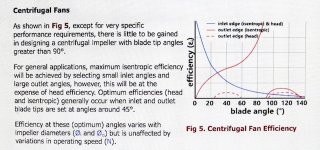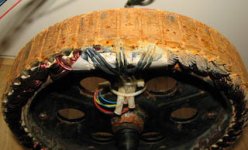I found this link with blower calculators for radial and centrifugal, it also has a lot of general info on all sorts of things
in the left column, and I think calculators for each. But I was disappointed to see a price tag attached.
Still, lots of good free information.
Calculators; http://calqlata.com/productpages/00060-help.html
At any rate, they show a graph with blade angles, and mentioned something about 45 degrees being an optimal angle.
I'm probably misunderstanding it, but you probably have it right already.


Just a thought but, at the RPM's you are going to see, I have to wonder if there might be a 'siren' affect, I think,
as they are constructed much the same? Maybe not.
Fechter, I think In general, they use straight blades because they have a consistent pressure over an RPM range, and are
not prone to gathering dust, but they are also the most noisy. (shop-vac's) I think backwards blades are the most quiet,
and least power hogging. Your right, they are probably the best bet, as there will be a lot of restriction of flow.
As far as aluminum wire goes, I wonder if a copper plated aluminum Litz or multi strand would have more copper content
than single strand? Probably not saving a lot of weight, but any is better.




